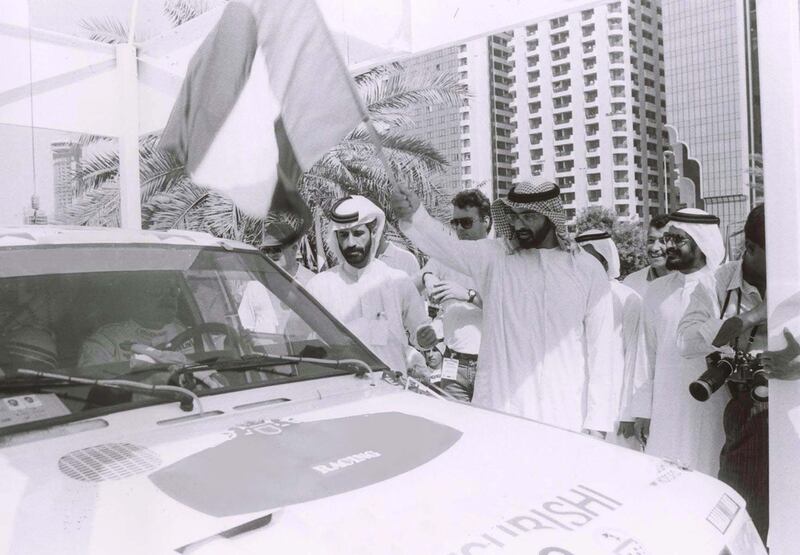The roots of the UAE Desert Challenge can be traced back to a heavily notarised napkin in a fast-food outlet on Al Diyafah Street.
It was 1991 and Mohammed ben Sulayem, the UAE’s most distinguished racing driver, was eating alongside Irishman Sean O’Connor in a Pizza Hut.
The two men, both infatuated with motorsport and residing in Dubai, were discussing what they needed to do to help the sport grow.
Ben Sulayem took a napkin and started jotting down ideas and running numbers, calculating how much money was required to make an endurance rally happen.
“I wish I had kept it,” he said recently. “On that napkin, we had laid out all the details; then I got Philip Morris to say he would support us.”
The Emirati took his napkin and his statement of support from the American tobacco owner to a man who could make things happen.
“I took these two pieces to His Highness Sheikh Mohammed bin Rashid. He was playing tennis, but he looked at me and said ‘I see you have something Mohammed, what do you want?’”
Ben Sulayem told the future Vice President and Ruler of Dubai that he wanted to create a large-scale, cross-country rally event in the desert. Sheikh Mohammed’s response was as straight as a forehand down the line: “Where do you want to take it? To what level?”
Ben Sulayem replied: “To the world level.”
Sheikh Mohammed acknowledged his compatriot’s ambition and passion and gave his support. The meeting was over, the tennis match resumed, and so was born the UAE Marlboro Desert Challenge.
The event has evolved throughout the years and celebrated its 25th anniversary in April in Abu Dhabi’s Empty Quarter, but in 1991, the race was limited to Dubai and Sharjah. Large posters were stuck up all over the two emirates, detailing the what, when and why of it all. One such advertisement remains proudly on display at the offices of the Automobile and Touring Club of the UAE in Al Mamzar.
“I remember hearing about the race,” recalls Mohammed Al Balooshi, who was the UAE’s first Red Bull-sponsored athlete and now rides for KTM-UAE. “At that time my priorities were different; I was only really doing motocross and bajas so, for me, it wasn’t a big thing. But I do remember it creating a bit of a buzz.”
The two-day, 300km-plus race was won by an Emirati named Mohamed Mattar in a Land Rover Defender and, the following year, with the race having expanded to include a 10km stage in Abu Dhabi, Mattar successfully defended his title. There may have been no bivouac for the drivers to camp at in those days, but spreading to the UAE’s largest emirate proved a key step in the development of the race.
“Up until 1992 there were no events in Abu Dhabi for motorsports, so that first short stage near to the airport was really the start of motorsport in the capital,” said Ben Sulayem, who flagged off the start of the stage alongside Sheikh Mohammed bin Zayed, the future Crown Prince of Abu Dhabi and Deputy Supreme Commander of the Armed Forces.
“Sponsors have obviously came and went since then, but the race has always survived. To sustain it for 25 years is something we should be proud of.”
In 1995, the Desert Challenge became a leg of the FIA Cross-Country Rally World Cup for drivers and manufacturers and, three years later, it became affiliated with the FIM Cross-Country World Championship for motorbikes and quads. As the event grew, so did the entry field, with drivers and riders from all corners of the globe turning out to compete.
At the turn of the 21st century, shortly after the September 11 attacks on New York’s World Trade Center towers, the race suffered a 20 per cent drop in entrants and a few years later was hurt by the global recession. The Abu Dhabi Government, aware that a part of the country’s motorsports history was under threat, stepped in.
Since 2009, the five-day race has been organised as the Abu Dhabi Desert Challenge and has been held entirely in the emirate. It is widely regarded as the most challenging rally outside of Dakar, regularly attracting the best endurance drivers in the world.
“You can go to see any tennis tournament and once you are inside the arena, you can be anywhere in the world,” Ben Sulayem said. “For our race though, it is an advert for the country in itself. When you see the dunes or Qasr Al Sarab or wherever, you immediately know it is the Abu Dhabi Desert Challenge, the capital and the UAE in general.”
gmeenaghan@thenational.ae
Follow us on Twitter @NatSportUAE





